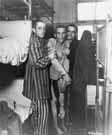
|
|
|

|

|

|

|
|
Click on an image to see a larger, more detailed picture.
|
|
|
|
|
| 1945: Liberation and Rebuilding |

|
pg. 604 |

|
|
|
|
| |
 The Flossenbürg, Germany, work camp, where prisoners labored in a stone quarry and in the manufacture of arms and munitions, had functioned since 1938. Camp personnel evacuated prisoners from the facility on April 20, 1945, setting the inmates forth on an eight-day death march toward Dachau. American troops reached Flossenbürg and liberated the few inmates who remained on April 23. Hastily buried bodies of prisoners who had perished or been murdered lined the route of the march. General George Patton was appalled by the deaths and the makeshift graves that would have to be exhumed. He issued a blunt command: "I want no American soldier digging for these bodies. Round up the town Bürgermeister and whatever civilians are available and have them commence digging." The German women seen here were among those conscripted for that duty.
The Flossenbürg, Germany, work camp, where prisoners labored in a stone quarry and in the manufacture of arms and munitions, had functioned since 1938. Camp personnel evacuated prisoners from the facility on April 20, 1945, setting the inmates forth on an eight-day death march toward Dachau. American troops reached Flossenbürg and liberated the few inmates who remained on April 23. Hastily buried bodies of prisoners who had perished or been murdered lined the route of the march. General George Patton was appalled by the deaths and the makeshift graves that would have to be exhumed. He issued a blunt command: "I want no American soldier digging for these bodies. Round up the town Bürgermeister and whatever civilians are available and have them commence digging." The German women seen here were among those conscripted for that duty.
Photo: Drew University Center for Holocaust Study
|
 Lice and fleas were among the banes of existence for concentration-camp inmates. Not only did these vermin make camp life even more unbearable, but they also carried disease. Hence, the Allies made a concerted effort to help former prisoners to end infestations. Here, an American soldier disinfects survivors of the Flossenbürg, Germany, camp.
Lice and fleas were among the banes of existence for concentration-camp inmates. Not only did these vermin make camp life even more unbearable, but they also carried disease. Hence, the Allies made a concerted effort to help former prisoners to end infestations. Here, an American soldier disinfects survivors of the Flossenbürg, Germany, camp.
Photo: Rijksinstituut voor Oorlogsdocumentatie/United States Holocaust Memorial Museum Photo Archive
|
 The diets that camp inmates received had profound long-term effects upon their digestive systems. Among the results of prolonged malnutrition were severe cases of dysentery, many of which proved fatal even after liberation. Here, a young Czech man suffering from a serious case of the disease is helped by two other survivors of the Flossenbürg camp.
The diets that camp inmates received had profound long-term effects upon their digestive systems. Among the results of prolonged malnutrition were severe cases of dysentery, many of which proved fatal even after liberation. Here, a young Czech man suffering from a serious case of the disease is helped by two other survivors of the Flossenbürg camp.
Photo: National Archives/United States Holocaust Memorial Museum Photo Archive
|
|

|

|

|

|
 April 12, 1945: SS troops evacuate inmates of the camp at Schönebeck, Germany, to Theresienstadt, Czechoslovakia.
April 12, 1945: SS troops evacuate inmates of the camp at Schönebeck, Germany, to Theresienstadt, Czechoslovakia.
|
 April 12, 1945: U.S. President Franklin Roosevelt dies. Vice-president Harry S. Truman becomes president.
April 12, 1945: U.S. President Franklin Roosevelt dies. Vice-president Harry S. Truman becomes president.
|
 April 13, 1945: Soviet troops enter Vienna.
April 13, 1945: Soviet troops enter Vienna.
|
 April 13, 1945: Death marchers from the small labor camp of Rottleberode, a subcamp of Dora-Mittelbau, are driven to the outskirts of Gardelegen, Germany, which they had reached two days before. The just over 1000 prisoners are herded by SS guards and members of the local militia into a barn, which has been prepared as an execution site. As the last prisoners are pushed into the barn, the SS guards throw torches onto the gasoline-soaked straw and lock the doors. Those prisoners who are not killed by the smoke and fire are shot by the SS as they try to escape. Only a few of the prisoners survive; See April 14, 1945.
April 13, 1945: Death marchers from the small labor camp of Rottleberode, a subcamp of Dora-Mittelbau, are driven to the outskirts of Gardelegen, Germany, which they had reached two days before. The just over 1000 prisoners are herded by SS guards and members of the local militia into a barn, which has been prepared as an execution site. As the last prisoners are pushed into the barn, the SS guards throw torches onto the gasoline-soaked straw and lock the doors. Those prisoners who are not killed by the smoke and fire are shot by the SS as they try to escape. Only a few of the prisoners survive; See April 14, 1945.
|
|
|
|
|
| 1945: Liberation and Rebuilding |

|
pg. 604 |

|
|
The Holocaust Chronicle
© 2009 Publications International, Ltd.
|
|
